[Source: Darren Kitson]
The Marchwood Military Railway began life in 1939 with the spur from Marchwood Junction to Cracknore Hard magazine. Military railways were not shown by the Ordnance Survey until circa 1960 so the situation prior to 1943 is difficult to determine in respect of the Cracknore Hard spur. The term 'spur' is used for this period to distinguish it from 'branch', the term used for what remained following the building of the military railway-proper in 1943. To recap from earlier, the Cracknore Hard spur was 1¼ miles long and served a magazine, at which location the single track appears to have divided into two sidings which continued the short distance to Cracknore Hard jetty and this end of the spur is now abandoned with just two short lengths of embedded track remaining in front of the jetty. At the time of writing, however, it remains unclear if these lengths of track were part of the spur or served some other purpose. Either way, the easternmost 700-or-so yards of the spur are now abandoned and the course obliterated. The remainder is intact as of 2016 but appears to be disused.
The military port would not have been considered a port in the true sense of the word when it opened in November 1943 and 'barracks with jetty' would have been a truer description; its initial purpose being its involvement with D-Day. With the original set-up of a single rail served jetty (Deep Water Jetty, later Mulberry Jetty) the track layout, ignoring the Cracknore Hard spur, would have comprised reception (or exchange) sidings, probably on the site they currently occupy, a small locomotive shed and phenomenal siding capacity in addition to the reception sidings. It is generally accepted that the original layout comprised some 22 miles of track, that is three times the route mileage of the Fawley branch, and much of which would have been sidings. Some idea of the extent of track at the jetty end of the system can be gained from the earlier photographs showing construction of Mulberry components. The relatively high original track mileage can be partially explained by the presence of a large number of rail-mounted steam cranes; these would have dictated a need for additional tracks in order to carry out their duties without interfering with traffic flows. The cranes would also have required some sort of servicing facility, probably as an annex to the locomotive facilities, and this would have involved more trackwork.
As with goods facilities on the main lines, the track layout of military systems has a habit of changing from time to time and track mileage at Marchwood peaked at around 30 miles at some point in its history. This is in stark contrast to the present (2016) 7 to 7½ miles. The map, below, show the track layout as it is believed to have been in the early 21st century and, of course, after construction of Falklands Jetty in the 1980s. The original full extent of the Cracknore Hard branch and the temporary 1956 spur to Marchwood power station is not shown. Also not marked is the gate across the single track curve leading to and from Marchwood Junction, or the trap points on the curve which are facing in the up direction. The gate is often assumed to be the Network Rail / MoD boundary, in fact the boundary is within the Reception Sidings and irrespective of these sidings being on MoD land but this detail is academic as only a few yards of track are involved. A similar situation exists at, for example, Fawley where tracks within the refinery boundary are owned by Network Rail. The tracks to the jetties at Marchwood are referred to as the Northern Line and Southern Line.

The Halts
The Marchwood Military Railway once had an internal passenger train service. Most sources state that there were three halts but there were, in fact, four; Mulberry; Port Gate; Model Room and Jetty. Model Room Halt closed sometime around 1990 but the remaining three remained in use until the passenger service was withdrawn in October 2013. The halts are covered separately within the Disused Stations website. Readers are nevertheless reminded that Mulberry Halt did not service Mulberry Jetty as the name implies but the married quarters at the western end of McMullen Barracks.
Like many details of the military railway's earlier years, quite when the passenger service was introduced is unclear. Some sources claim circa 1960 but the service is known to have been operating during the 1950s and may even have commenced soon after the end of World War II. The oldest photograph of a passenger train which has been seen to date is from May 1958 and shows a single carriage of what appears to be L&SWR origin. As was normal with military railways, rolling stock was invariably ex-main line and unlike locomotives it is notoriously difficult to trace the subsequent history of rolling stock once disposed of by the main line railway companies; notoriously difficult, that is, apart from more recent years and fortunately some details of rolling stock, passenger and goods, at Marchwood from the 1970s onwards are known and will be covered in due course, either as and when they appear in photographs where few details are known or in the text, where reliable information has been found.
Steam Locomotive
Steam locomotives on Marchwood Military Railway appear to all been, perhaps unsurprisingly, of the Austerity 0-6-0ST type and their history is interesting and a little quirky.
During preparation for WWII the War Department opted for the LMS 'Jinty' 3F 0-6-0T design as its standard shunting locomotive. The scheme was advanced enough to see eight of the type sent to France as WD 8 - 15 in 1940, just prior to the German invasion of that country. Of these, five returned home in 1948 having ended up with SNCF (French National Railways), two were lost and another is believed to have ended up with Deutsche Reichsbahn (German State Railway). A further two were re-gauged and sent to the Northern Counties Committee (Northern Ireland) where they became NCC Nos. 18 and 19. A further batch of, believed five, Jinties were earmarked for France but in the event were never sent. The five which returned home had officially been classed as withdrawn (routine paperwork procedure in these circumstances) but went on to become British Railways Nos.47589/607/11/59/60
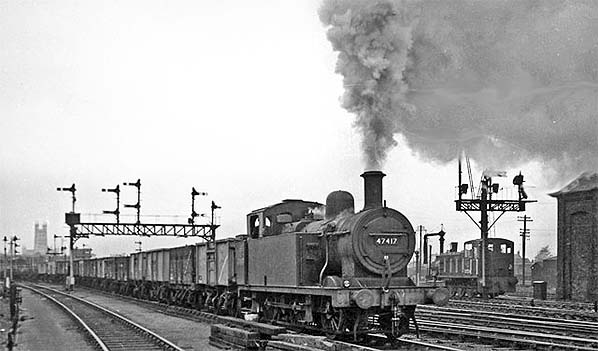
Fowler Class 3F Jinty 0-6-0T at Tramway Junction, Gloucester, on 1 May 1961. Gloucester Horton Road shed is partially visible on the right together with a diesel shunter of what would become Class 03.
Photo by Ben Brooksbank
Following the sending of eight Jinties to France, this is when the story became a little quirky. The other five Jinties due to go to France presumably remained at home owing to the German invasion and the Hunslet Engine Co appears to have seized upon this lull to approach the War Department with 'arm twisting' in mind regarding its own 0-6-0ST design. Hunslet must have twisted some arms to a rather painful degree as the War Department changed its mind and opted to abandon the Jinty and adopt Hunslet's design instead, and what became known as the 'Austerity Saddle Tank' appeared from January 1943 onwards. The reason was apparently the ability of the Hunslet design to be serviced without the requirement for a pit. Thus, whilst it is reasonable to assume some Austerities went to Marchwood brand new, it should be borne in mind that the War Department received all 377 built during the war brand new so Marchwood was in no way unique. The type, incidentally, continued to be built up to 1964 by which time the total was 485 but not all the post-war examples went to the military.
The Austerity had its origins in a design harking back to 1923 which morphed into Hunslet's 48150, or '18in class' from their cylinder diameter, built for industrial service with Guest Keen Baldwins Iron & Steel Company, a company better known today as GKN. The 48150 class developed into the 50550 class, of which the Austerity was a somewhat simplified version. The main visual difference between classes 48150 and 50550 was the saddle tank of the former not extending over the smokebox and it thus, to modern eyes, had a somewhat more antiquated, but not unattractive, appearance. In contrast, the longer saddle tank of the 50550 and Austerity gave for a rather 'bullish' appearance.
Quite what argument Hunslet put to the War Department remains a mystery and the only plus point for the 50550 class might have been that it was more modern. The Jinty was an LMS locomotive but had its origins in earlier Midland Railway designs so, in its favour, it was a proven main line design which was capable of, and did, also work passenger trains. As to specification there was little difference between the Jinty and what became the Austerity; both were inside cylinder 0-6-0 tanks sharing the same cylinder dimensions; there was a ton or so weight difference (the Austerity was lighter); and boiler pressure differed by just 10lb (Jinty 160lb, Austerity 170lb). The Austerity, however, had smaller wheels and thus a slightly higher tractive effort (Jinty 20,835lb, Austerity 23,870lb).
As might be expected due to the pressures of wartime, the Austerity was built by a number of manufacturers under sub-contract from Hunslet. Barclay (AB), Bagnall (WB), Hudswell-Clarke (HC), Robert Stephenson & Hawthorns (RSH) and Vulcan Foundry (VF) all being involved as well as Hunslet (HE) themselves.
It is, and always has been, a problem keeping track of military locomotives, partly because military sites are normally visible to the public only from outside the perimeters and partly because locomotives are moved around frequently. Austerity locomotives known to have been at Marchwood are as follows:
WD 5091. HC 1752/1943. Delivered new to Marchwood November 43 and remained until 15/8/45. She ended up with the National Coal Board (NCB) and turned up at Bold Colliery named 'Robert'. She took part in the Rocket 150 shindig of May 1980 and is now preserved.
WD 75074. RSH 7110/1943 was at Marchwood February to May 1944 until transfer to Long Marston. She went to France in December 1944 and was later loaned to SNCB (Belgian National Railways). She ended up with Dutch State Mines in October 1945 and lasted until October 1958, presumably then scrapped.
WD 75040/Army 106 'SPYCK'. HE 2889/1943. This locomotive had an erratic history in respect of Marchwood, being present from 1944-49, then again from May to October 1955, the yetn again from May 1956 until May 1960. She then went to Longmoor and was withdrawn in December 1961, being later scrapped at Woodham's, Barry, in 1965.
WD 5054. RSH 7090/1943. At Marchwood 19 April to 1 May 1944. Sent to France in February 1955 but apparently never used and stored in Belgium. She was sold in June 1945 to Nederlandse Spoorwegen (Dutch State Railways) and became their No.8808. She was withdrawn 24 June 1955 and scrapped later the same year.
WD 5184. RSH 7134/1944. At Marchwood, presumably new, in May 1944 before moving to Bramley on 2 July 1945. This was the end of her military career for she was one of the type purchased by the LNER and was noted under repair at Stratford in June 1946. As Class J94 BR No.68022 she survived until September 1960 and was scrapped immediately afterwards at Darlington works. What became Class J94 will be covered later.
WD 75290/Army 186 'MANIPUR ROAD'. VF5280/1945. At Marchwood October 1950 - June 1953. Her subsequent location(s) is not known but she was withdrawn sometime in 1960 and was one of a few bought by Hunslet, rebuilt and resold. She ended up with the NCB and lasted until June 1971.
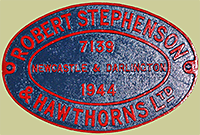 WD 75189/Army152 'RENNES'. RSH 7139/1944. Served at Marchwood June 1953 to May 1956 as the replacement for WD 75290. Her next three years allocations are unknown but it is known that she lasted with the military only until 1959, after which she became another example rebuilt and resold by Hunslet to the NCB. She is now (2016) preserved at the Pontypool & Blaenavon Railway where she is be restored into LMR (Longmoor) livery, although this should not be taken as any proof that she was at Longmoor at any time during her military career. Nevertheless, Longmoor was often the last port of call for Army locomotives prior to disposal.
WD 75189/Army152 'RENNES'. RSH 7139/1944. Served at Marchwood June 1953 to May 1956 as the replacement for WD 75290. Her next three years allocations are unknown but it is known that she lasted with the military only until 1959, after which she became another example rebuilt and resold by Hunslet to the NCB. She is now (2016) preserved at the Pontypool & Blaenavon Railway where she is be restored into LMR (Longmoor) livery, although this should not be taken as any proof that she was at Longmoor at any time during her military career. Nevertheless, Longmoor was often the last port of call for Army locomotives prior to disposal.
WD 75277/Army 178 'FOLINGO'. RSH 7207/1945. At Marchwood October 1954 to April 1955 when she went to Longmoor. Her subsequent fate was the same as WD 75040.
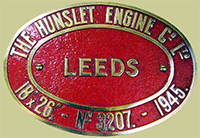 WD 71443/Army 157 'CONSTANTINE'. HE3207/1945. Little is known of this locomotive other than that she was at Marchwood from November 1955 until November 1958 and that she was withdrawn during 1962 and scrapped at Pollock & Brown, Southampton, sometime between then and March 1968. Curiously, however, there is a record of 'a' WD 157 ending up with Nederlandse Spoorwegen as their No.8802 but scrapped in October 1956. This must be assumed to be a different locomotive or possibly an error in the records.
WD 71443/Army 157 'CONSTANTINE'. HE3207/1945. Little is known of this locomotive other than that she was at Marchwood from November 1955 until November 1958 and that she was withdrawn during 1962 and scrapped at Pollock & Brown, Southampton, sometime between then and March 1968. Curiously, however, there is a record of 'a' WD 157 ending up with Nederlandse Spoorwegen as their No.8802 but scrapped in October 1956. This must be assumed to be a different locomotive or possibly an error in the records.
WD 192/92 'WAGGONER'. HE 3792/1953. This example is perhaps the best known of all the military Austerity locomotives. Sent was sent to Marchwood on 26 June 1973 and became the regular on the internal passenger service. She was destined to become the final military steam locomotive at Marchwood, bowing out on 28 March 1979. She is now preserved, as of 2016, at the Isle of Wight Steam Railway, and had remained in Ministry of Defence ownership until as late as 2008. She has been on the Isle of Wight since February 2005.
The above should not be taken as a complete list of Marchwood's steam locomotives as there were probably others at various times. Their work was also shared with diesel locomotives of various types. Named military locomotives almost always had their names presented in block capitals, hence names are given here in this form. Those with five digit numbers starting with '7' were originally numbered with only the second to fifth digits, for example WD 71443 was previously WD 1443. The addition of the prefixing '7' was intended to indicate locomotives either operating abroad or intended to operate abroad but in many cases 7xxxx numbered locomotives never went and remained at home. This was not a government error but the result of changing requirements as the war progressed. Others, however, remained at home during the war but served overseas subsequently.
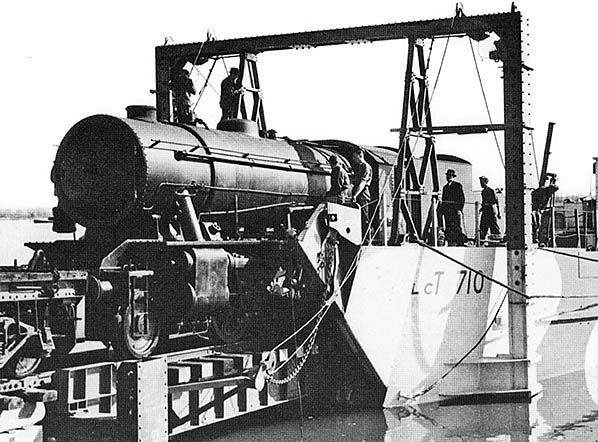
Shortly before the end of the war loading trials are being undertaken at Marchwood with WD 'Austerity' 2-8-0 No.79250 and LcT (Landing craft Tank) pennant number 710. This vessel could take the weight of the 2-8-0 when not in working order, meaning with empty bunker, tank and boiler. This was normal for the shipping of locomotives, not only for weight reasons but also stability when at sea. It would appear the bow of the vessel had been modified as ordinarily the bow consisted of a ramp which was lowered onto a beach for the driving off of tanks etc. The gantry is part of the vessel and was not a standard fitting on this, the Mark 6, landing craft so will be a further modification. At far left, a barrier wagon with diamond-frame bogies is being used between the 2-8-0 and the shunting locomotive which was probably an Austerity 0-6-0ST. The use of a barrier wagon would have been for reasons of weight distribution. Precisely when shipping of the WD locomotives to Europe began is by no means clear, sources usually referring only to 'after D-Day' in June 1944. WD No.79250 was new in January 1945 (Vulcan Foundry w/n 5193/45) and by this date it is likely several examples had already been shipped, so the trial at Marchwood was perhaps for a more efficient loading method of a 'roll on - roll off' nature. Of the 935 WD 2-8-0s built, those intended for service abroad had their numbers prefixed with a '7', either when new or retrospectively. However, not all of them went abroad and among these was No.79250. She ended up on the Longmoor Military Railway as No.401 and named Major - General Mc Mullen (apparently with the space between the Mc and Mullen). At Longmoor No.401 kept company with No.400 Sir Guy Williams which as WD No.7337 had been the locomotive involved in the Soham explosion of 2 June 1944. Major - General Sir Donald McMullen CB KBE DSO RE, as he became, was a veteran of both World Wars and had been in regular contact with R.A.Riddles, designer of the WD 2-8-0 and 2-10-0, and bestowed great praise on the design which was based upon the Stanier 8F but with a number of significant differences commensurate with wartime. Major - General McMullen died on 12 November 1967 but his name lives on as Marchwood's McMullen barracks, built in 1956, was named after him. Locomotive No.401 survived until February 1957. No.401, which had been one of those intended to serve abroad and as No.77337 indeed did so, being returned home in 1946, was taken out of use in 1965 and believed scrapped at Longmoor during 1967. Initially known by the British as 'Tank Landing Craft' (TLC), this type of vessel was a British development later taken up by the United States (US) who termed them 'Landing craft Tank' as already described and this designation was to become adopted by the Royal Navy. Initially the US supplied many vessels (and a host of other equipment) under President Roosevelt's 'Lend - Lease' scheme which supplied aid to no less than 36 nations. LcT 710 was built by the Pidgeon-Thomas Iron Co. at Memphis, Tennessee and launched on 27 December 1943. She was then taken together with 709, 712, 713 , 714 and another assumed to be 711 to New Orleans for fitting-out by the US Navy. Intended for the Europe-Africa-Middle East Theatre, LcT 710 is known to have taken part in Operation Neptune, the seaborne phase of the Normandy Landings - Operation Overlord, in June 1944. She was 119ft 1in long with 32ft 8in beam and maximum draft of 5ft. Her range was 700 nautical miles at 7 knots and maximum designed speed 10 knots, with a cargo capacity of 150 short tons (A US unit equating to 2,000 pounds, the British ton, or long ton, being 2,240 pounds). Armament was two single 20mm anti-aircraft gun mounts and four .50 calibre machine guns. Propulsion was by three Grey Marine 6-71 diesel engines driving triple screws with 675shp (shaft horsepower). There was also two diesel-electric service generators of 10kW 120V DC output. Complement was one officer and twelve enlisted (broadly this means any rank below commissioned officer). The LcT Mark 6 was, perhaps obviously, a variation of the Mark 5. Differences were the addition of a stern gate to permit the craft to act as a bridge between other vessels and, as a result, the positioning of the wheelhouse on the starboard side, that is on the right when looking towards the bow. In other respects the Mark 6 was similar to the Mark 5. Unlike many wartime landing craft, the LcT's remained in service and in 1952 were redesignated to LCU (Landing Craft Utility). A few still exist but as far as is known none are of the Mark 6 version. The eventual fate of LcT 710 is unrecorded, suggesting she was scrapped at the end of hostilities.
Photo from Andy Crespin collection
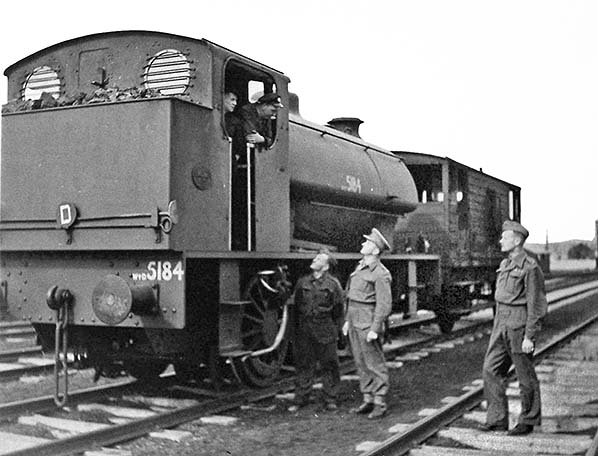
Austerity WD 5184 with brake van at Marchwood sometime between May 1944 and July 1945. The photograph was almost certainly deliberately posed, showing an officer and two ratings chatting to the footplate crew. Note the arrow between the W and D, the once familiar symbol which could be found on virtually anything owned or formerly owned by the government. The devices lying across the lamp brackets are fire irons: tools used for tending the fire, raking ash and so on. WD 5184 went on to become British Railways Class J94 No.68022, in which form she looked rather different, as seen here. Note the track, standard military flat bottom rail on concrete sleepers.
Photo from the National Archive
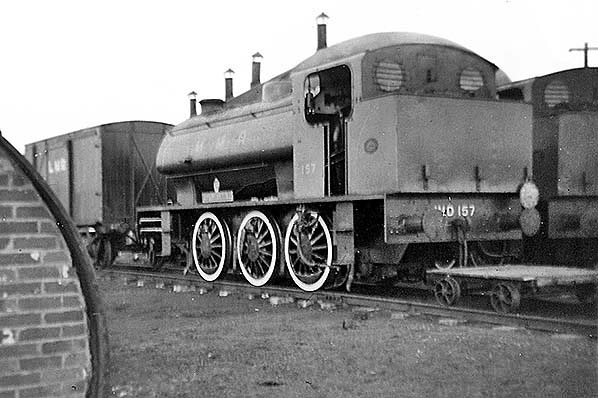 Austerity WD 157 CONSTANTINE standing adjacent to the original locomotive shed, seen in the background, at Marchwood. The photograph was taken by a platelayer of the time who suggested the date "circa 1956" although given WD 157 was at Marchwood only for three years from November 1955 "circa" could arguably cover that entire period. Whatever the date, quite what was occurring is something of a mystery as the locomotive is dumped on a siding minus coupling rods and sandwiched between a platelayer's trolley and a van. She has MMR on her tank and white rimmed tyres which appear freshly painted (on railway wheels, especially locomotive wheels, a 'tyre' is a separate, flanged, component which is heated up and placed over the wheel which it then grips securely as it cools and contracts). The painting of rims in this manner was popular with the military, especially at Longmoor, and was also applied to some main line locomotives, usually diesels, especially when brand new, ex-works, for official photographs. It was not, however, very practical as the white soon became filthy. Often referred to as 'whitewall tyres', this term more correctly applies to road vehicles. WD 157 was photographed at Longmoor shortly before she moved to Marchwood but on that occasion did not have white rims. Similarly she did not appear to have white rims when photographed on the power station spur in January 1956 (photo below). The conclusion, therefore, is that this photograph dates from the time of her arrival at Marchwood, ie November 1955, and when she was being prepared for service. Readers may suspect the missing coupling rods were due to her being towed from Longmoor to Marchwood but locomotives being so-transferred usually did so under their own power. Close examination of her wheels shows the cranks to be in the same positions (roughly in the 11 o'clock position) and this tells us the coupling rods were removed after she arrived on the siding as seen here but the reason why is now lost in the mists of time. It is highly unlikely the rods were removed merely to facilitate painting the tyre rims as this can be done with rods in situ, although the absence of the rods probably encouraged a tin of white paint to appear. The goods van is marked 'LMR', ie Longmoor Military Railway. It is often forgotten that locomotives were not the only vehicles to be moved from depot to depot and it is possible this van, which is strongly suspected of being of Midland Railway origin, came to Marchwood with No.157. At far right another Austerity can be seen, it is likely to be either No.152 RENNES or No.106 SPYCK. Both display the usual bars over the cab rear lookouts, their purpose being to protect the glass from damage by coal. On the left part of another Nissen type building can be seen, purpose unknown. WD 157 was back at Longmoor by 1966 and in that year appeared in the film The Great St.Trinians Train Robbery. One of two Austerities used in the film, the other being WD 196, she was for some mysterious reason given dummy side tanks and in this form vaguely resembled an LNER/BR Class J50. She was also given BR livery and the number 68961; a real J50 which had been withdrawn in September 1962.
Austerity WD 157 CONSTANTINE standing adjacent to the original locomotive shed, seen in the background, at Marchwood. The photograph was taken by a platelayer of the time who suggested the date "circa 1956" although given WD 157 was at Marchwood only for three years from November 1955 "circa" could arguably cover that entire period. Whatever the date, quite what was occurring is something of a mystery as the locomotive is dumped on a siding minus coupling rods and sandwiched between a platelayer's trolley and a van. She has MMR on her tank and white rimmed tyres which appear freshly painted (on railway wheels, especially locomotive wheels, a 'tyre' is a separate, flanged, component which is heated up and placed over the wheel which it then grips securely as it cools and contracts). The painting of rims in this manner was popular with the military, especially at Longmoor, and was also applied to some main line locomotives, usually diesels, especially when brand new, ex-works, for official photographs. It was not, however, very practical as the white soon became filthy. Often referred to as 'whitewall tyres', this term more correctly applies to road vehicles. WD 157 was photographed at Longmoor shortly before she moved to Marchwood but on that occasion did not have white rims. Similarly she did not appear to have white rims when photographed on the power station spur in January 1956 (photo below). The conclusion, therefore, is that this photograph dates from the time of her arrival at Marchwood, ie November 1955, and when she was being prepared for service. Readers may suspect the missing coupling rods were due to her being towed from Longmoor to Marchwood but locomotives being so-transferred usually did so under their own power. Close examination of her wheels shows the cranks to be in the same positions (roughly in the 11 o'clock position) and this tells us the coupling rods were removed after she arrived on the siding as seen here but the reason why is now lost in the mists of time. It is highly unlikely the rods were removed merely to facilitate painting the tyre rims as this can be done with rods in situ, although the absence of the rods probably encouraged a tin of white paint to appear. The goods van is marked 'LMR', ie Longmoor Military Railway. It is often forgotten that locomotives were not the only vehicles to be moved from depot to depot and it is possible this van, which is strongly suspected of being of Midland Railway origin, came to Marchwood with No.157. At far right another Austerity can be seen, it is likely to be either No.152 RENNES or No.106 SPYCK. Both display the usual bars over the cab rear lookouts, their purpose being to protect the glass from damage by coal. On the left part of another Nissen type building can be seen, purpose unknown. WD 157 was back at Longmoor by 1966 and in that year appeared in the film The Great St.Trinians Train Robbery. One of two Austerities used in the film, the other being WD 196, she was for some mysterious reason given dummy side tanks and in this form vaguely resembled an LNER/BR Class J50. She was also given BR livery and the number 68961; a real J50 which had been withdrawn in September 1962.
Photo from Andy Crespin collection
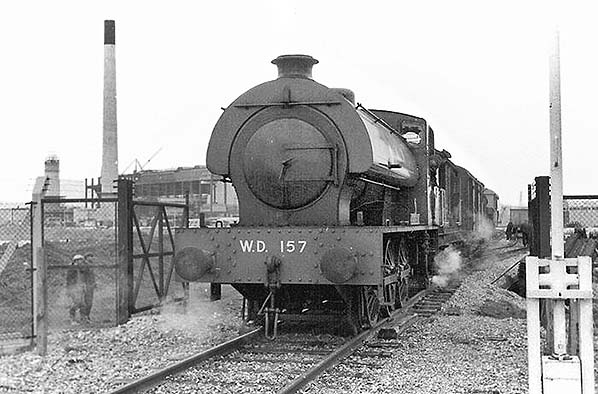
Austerity WD 157 ‘CONSTANTINE’ on the temporary spur laid for the construction of Marchwood power station. The date is January 1956 and the photograph is taken from the level crossing on Cracknore Hard Lane, one of the lifting barriers for which can be seen on the right. Materials for the power station were brought in via the Fawley branch, after which the army took over. On this occasion WD 157 was reversing a large transformer into the site. This power station was the first at Marchwood, located in the same general area as the present power station but a little further to the south-west. There are a couple of points to note. First, the track; although laid temporarily it is to a high standard and properly ballasted as would be expected of the military. Secondly, although the locomotive is not fitted with train brakes it has a screw coupling. Compare this to other photographs which show the reverse scenario. Today, 2016, the area beyond the gate is used for container storage whilst, now hidden by undergrowth, is a set of gates which appears suspiciously similar to those seen in this view. No trace remains of the level crossing. The spur to the power station presumably connected to the Cracknore Hard branch but it has not been possible to confirm this particular detail.
Photo from Andy Crespin collectionss
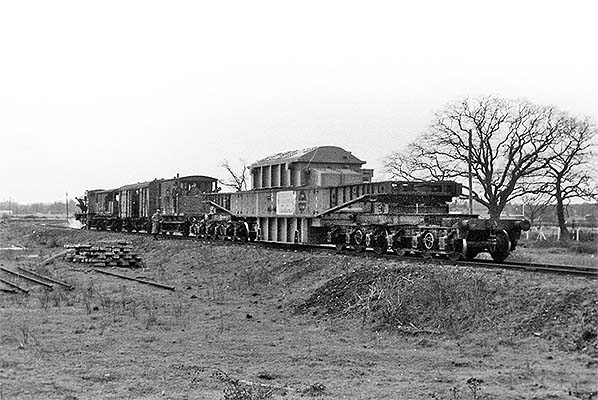
A new transformer for the original Marchwood Power Station being shunted along the specially-constructed spur from the military railway to the power station on 22 January 1956. The train is about to negotiate the level crossing over Cracknore Hard Lane, which is out of view to the right, and pass through the gate into the power station site. Note, left background, the sharp curve from the Cracknore Hard branch which is also just visible far left background. The transformer wagon appears to be a Diagram 2/470 'Transformer MC', one of a pair built for BR by Messrs. Head Wrightson of Thornaby in 1953 and thought to be the final such wagons built for use on British Railways. The weight of the transformer is not known. The locomotive is Austerity WD 157 and also in the train is a BR brake van, an ex-SR brake van and what appears to be a CCT van. The ensemble was taken to Marchwood by a BR 350hp diesel shunter which at this time could have been a member of one of several different types. The diesel most likely took over at Eastleigh, where the train would have arrived from the transformer manufacturer. On arrival on the Marchwood Military Railway the diesel came off and the army took over. The inscriptions on the side of the transformer wagon are unreadable but the dark circular label is known to have stated 'This Beam Weighs 10 Tons'. There were also cast metal plates attached to the beams which stated load capacities and other details or instructions. The lighter coloured rectangular label was most likely a temporary adornment bearing wording along the lines off 'New Transformer For Marchwood Power Station' and probably also gave the weight and/or KWh of the transformer and its manufacturer. This sort of advertising was once very common with exceptional loads such as this, both on rail and road. The transformer would not have been the only piece of heavy kit delivered to the power station but details of other movements over the temporary spur, if any, are not known.
Photo from Andy Crespin collections

This photograph is included as it offers a rather better impression of a Transformer MC wagon. Unfortunately the date and location is unknown. At least one Transformer MC still existed in 1983 but the subsequent history of both is not known. They seem to have simply disappeared, presumably scrapped. Nevertheless, transformers are still carried by rail; for example Axiom Rail (as of 2016 a subsiduary of what had became DB Cargo) has a number of wagons but these are not as large and impressive as the Transformer MC. However, most such loads in Britain now travel by road, for all or part of the journey, on gigantic low-loaders which proceed at little more than walking speed. In contrast, over in Europe and elsewhere in the world a number of huge and impressive railway transformer wagons can still be seen. Their continued existence is due in no small part to the more generous loading gauges found abroad and the generally more pro-rail attitude found outside Britain.
British Transport Commission photo © National Railway Museum & SSPL reproduced under creative commons licence
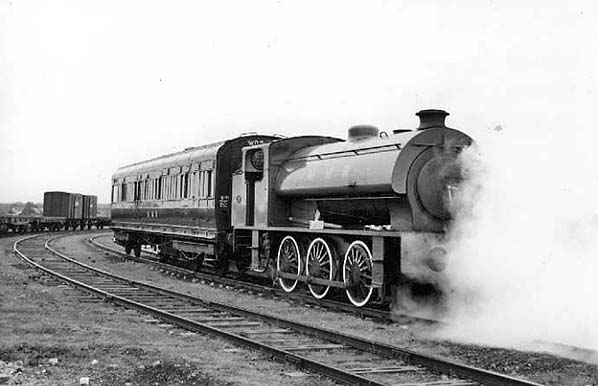
Army No.106 SPYCK seen here on 17 May 1958 with what is assumed to be a single-coach passenger train. The locomotive was Hunslet 2889/43 and had been numbered WD 75040. She spent intermittent periods at Marchwood, as was typical of military locomotives, and was withdrawn in December 1961 at, it is believed, Longmoor from where she was taken in August 1963 to Woodham's, Barry, for scrap.
Photo © Photos from the Fifties: Hugh Davies
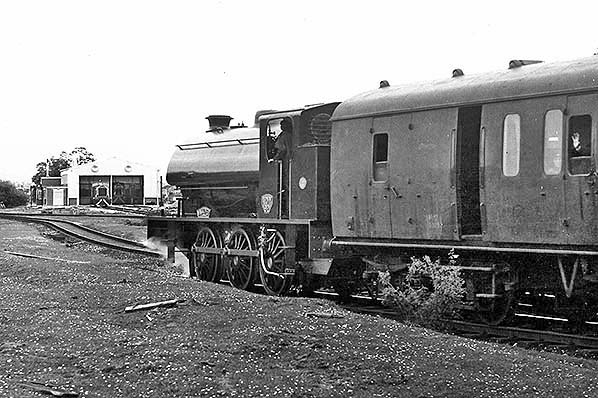
On 20 May 1974 Army No.92 WAGGONER heads the lunchtime passenger train from the exchange sidings, at which Mulberry Halt was located, towards Port Gate Halt (or 'Platform' as it was referred to by staff). The track on which WAGGONER is running is largely obscured by the raised surface in the foreground. The train is formed of the ex-BR suburban stock and coupled behind the locomotive is Army No. 5305, which came to Marchwood from Longmoor and had begun life as BR No.M43269. This is the vehicle withdrawn following collision damage and which can be seen in another photograph being scrapped during October 1977. In this view, the number ARMY 5305 can just be discerned stencilled to the lower bodyside ahead of the open guard's door. In the background the locomotive shed can be seen, obviously before the third bay was constructed, and present are Ruston & Hornsby Army No.425, left, and inside the shed on the right is North British Army No.405. Originally numbered WD 8305, No.405 had also operated at Bicester and Longmoor. She can be seen in other views within these pages and was to survive into preservation. Around the time of writing she was at the Colne Valley Railway, Essex, painted up as BR No.D2700 but unfortunately the real D2700, scrapped in 1963, had a different front-end appearance to Army No.405 so the latter's preservation era makeover is not especially convincing.
Photo by Brent Holloway and courtesy of Andy Crespin
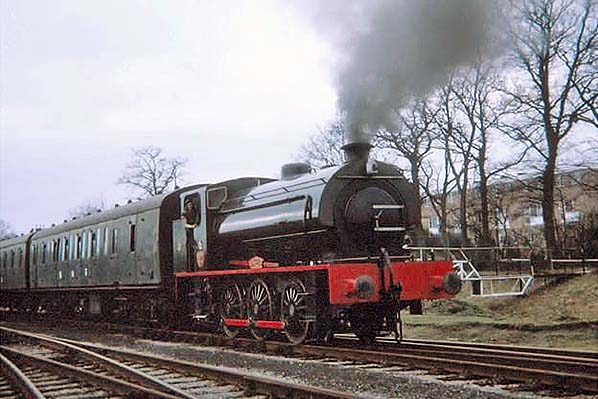
Army No.92 WAGGONER waiting at Mulberry Halt with the lunchtime passenger service to Jetty Halt in February 1976. Mulberry Halt was named after Mulberry Centre, Mulberry Road, part of McMullen Barracks married quarters. Part of the accommodation for service personnel can be seen on the right; these appear to be flats so are probably for singles. The MMR liveried coaching stock comprises the pair of ex-BR locomotive-hauled Mk1 suburban vehicles. The majority of these were built on 57ft underframes but there were also some built on 63ft 5in underframes as per the Mk1 corridor stock. There were a number of different internal layouts but all were non-gangwayed, ie no connection between adjacent vehicles. The last bastion of the type was the King's Cross and Moorgate (via the Widened Lines) suburban services and they finally bowed out following electrification from 1976. Variations, however, continued in use in suburban electric multiple-units for a great many more years.
Photo by Andy Crespin
Online references to the suburban coaches at Marchwood usually claim they came from King's Cross but this was not the case. They came to Marchwood from the Longmoor Military Railway subsequent to its closure in 1969 and had originated on BR London Midland Region. Three, not two, vehicles were involved and with army numbers in brackets had been Brake Seconds M43269 (5305) and M43296 (5313) plus Compartment Second M46069 (3301). The two Brake Seconds provided Marchwood's internal passenger service, coupled together, and ran with no vacuum brake but with a brakesman or shunter present in the guard's van to operate the handbrake wheel. The other coach, Army No.3301, was converted into an officers' saloon and used when senior army personnel visited the port. It was also used on a few of the early Open Days in the mid 1970’s hauled by vacuum-fitted WAGGONER. No.3301 ended up on the Mid Hants Railway in use as an office but was scrapped during the 1980s due to its poor condition. The two Brake Seconds were damaged in the collision with North British locomotive Army No.413 in 1976 which resulted in one the coaches being withdrawn with the other continuing in service on its own until replaced by the pair of ex-BR Mk1 corridor coaches which had appeared during, or by, 1978.
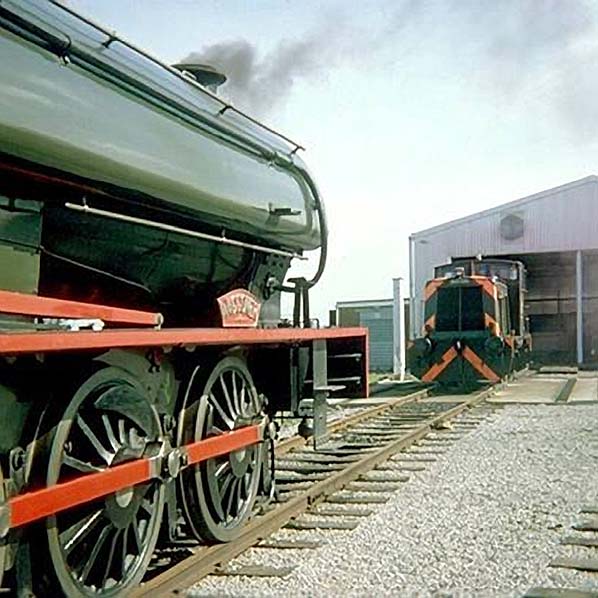
Army No.92 ‘WAGGONER’ looking immaculate in her green/red livery outside the locomotive shed in April 1976. This shed was built in 1972 replacing the WW2 shed nearby. Making sure that she gets into the picture is Ruston & Hornsby 0-6-0DH No.425. By this time the locomotive shed had three roads, more specifically two shed roads and a maintenance bay. A siding, well out of view to the right, was home to the railway's breakdown crane.
Photo by Andy Crespin
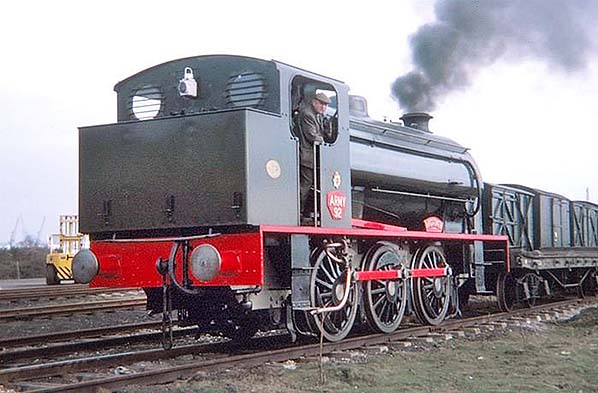
Army No.92 ‘WAGGONER’ shunting in February 1976, believed somewhere near the port. The locomotive is fitted with train brakes (vacuum) but, at the bunker end at least, retains an RCH three-link coupling. When operating internal passenger services, presumably the screw couplings of the stock were used. The vans, right background, are internal user and quite ancient with two of those visible having outside-framed bodies. The van nearest the locomotive is a Palvan and appears to be to a Southern Railway design built for the War Department. Introduced (by the main line railways) in an attempt to capture pallet traffic they were something of a white elephant as they were difficult to load unless there was a platform at both sides. The bogie flat coupled to the locomotive is a Rectank.
Photo by Andy Crespinn
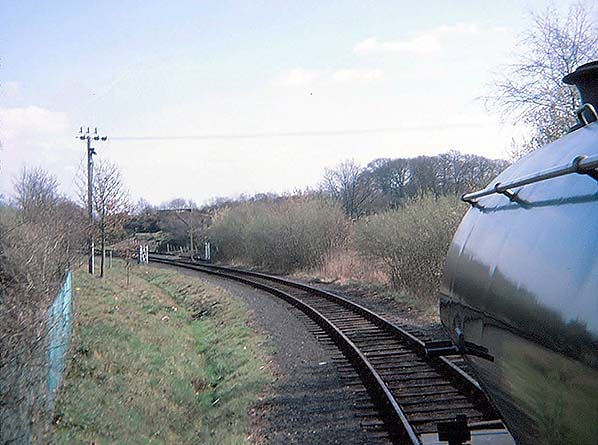
Army Austerity No.92 WAGGONER on the curve near Marchwood Junction in April 1976. Visible are the gates marking the boundary of MoD land and the loading gauge. This may appear an odd location for the loading gauge but the reception/exchange sidings commence a few yards beyond the gate and the points thereto would be visible were it not for the bushes on the left.
Photo by Andy Crespin
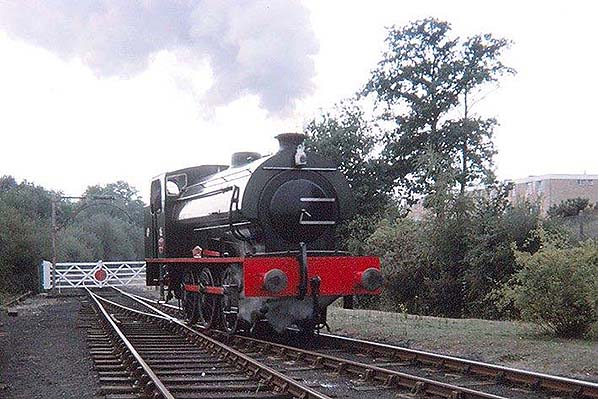
Army No.92 ‘WAGGONER’ in front of the gate beyond which is the curve leading to the Fawley branch in September 1975. It will be noted that the track uses bullhead rail; this is still British Rail (now Network Rail) track and the boundary is in the reception sidings, behind the camera, and not at the gate as is often assumed. Note the loading gauge. The two tracks fanning from the points divide again behind the camera to form the four (currently, 2016) reception sidings. Beyond that gate and just prior to the junction with the Fawley branch are trap points, facing in the up direction and controlled from Marchwood signal box. There are also two ground signals; one a Stop signal and the other
a rare Distant signal.
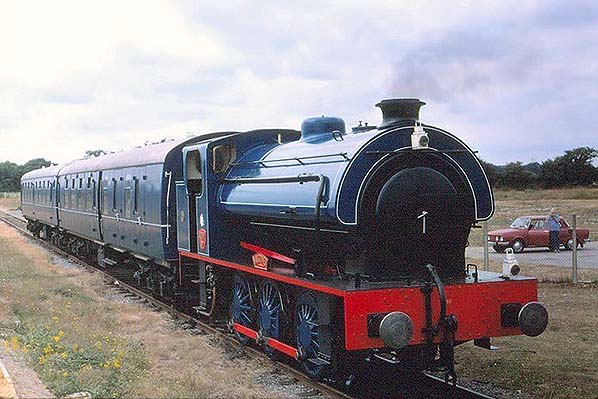
Army No. 92 ‘WAGGONER’ seen here in August 1978 posing in her new livery of blue lined white. Note the small '92' on the bufferbeam. In the right background No.92 has two more admirers, one being a Skoda Estelle and a 120 GLS model. The train comprises the two internal user ex-BR Mk1 coaches. The identity of the carriages is not known. BR Mk1 corridor stock was fitted with buckeye couplings (suburban stock was screw coupled) so presumably this pair were altered to screw couplings for use at Marchwood. The military acquired several carriages from BR, most being 57ft suburban types and it was a pair of the latter which the two seen here replaced. On 22 July 1978, not long before this photograph was taken, this train had operated shuttle services during one of the open days held to raise money for army charities.
Photo by Andy Crespin
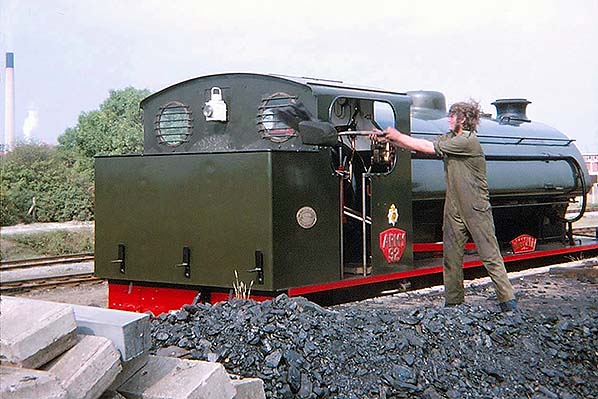
Army No.92 being coaled at the end of a day's work in September 1975. This view shows well the purpose of the bars over the rear cab lookouts. Other points to note are the spotless cab with polished brasswork, vacuum pipe along the side of the saddle tank and the Royal Corps of Transport regimental badge on the cabside (see below). The plate fixed to the bunker is the builder's worksplate. The fireman is Rob Wearn, who was actually a shunter but enjoyed assisting. Sadly, Rob is no longer with us. First impressions of the coal is that it was of poor quality and contained a lot of slack. In fact what we see here is the bottom of the heap and a new delivery of coal was due. No doubt Rob was carefully selecting what to shovel into the bunker and what to leave behind. 'Slack' is a term little-heard nowadays and refers to small pieces of coal and dust - the dregs in other words. Householders sometimes purchased slack because it was cheap but it was difficult to burn in domestic fireplaces and required frequent poking. It was, however, useful for 'keeping the fire in overnight', as people termed it. Marchwood's coaling stage was located just west of the locomotive shed, to the south of the running lines and in the 'V' between the latter and the spur to Roberts Camp. There was also an elevated siding for coal wagons at the opposite face of the coaling stage and out of view behind the camera in this picture. In addition there was once an ashpit between the coaling stage and engine shed, to the right of this view, but the pit was infilled sometime during the 1960s requiring the fire to thereafter be thrown-out alongside the track. To assist further in getting bearings, the exchange sidings are located a little way off to the left while, left background, Marchwood's first power station can be seen.
Photo by Andy Crespin
 The regimental badge of the Royal Corps of Transport (RCT). The inscription "Honi soit qui mal y pense" is an Anglo - Norman maxim which loosely translates to "May he be shamed who thinks badly of it". The RCT's motto was "Nil sine labore" which translates to "Nothing without labour". As is typical within the military, the RCT had a number of nicknames of which some, based upon the initials 'RCT' were ever so slightly lampooning. However, one which was less lampooning was 'The Waggoners' and hence the WAGGONER name given to locomotive Army No.92. The Royal Corps of Transport was disbanded in 1993 and merged with other Corps to form the Royal Logistic Corps on and from 5 April that year.
The regimental badge of the Royal Corps of Transport (RCT). The inscription "Honi soit qui mal y pense" is an Anglo - Norman maxim which loosely translates to "May he be shamed who thinks badly of it". The RCT's motto was "Nil sine labore" which translates to "Nothing without labour". As is typical within the military, the RCT had a number of nicknames of which some, based upon the initials 'RCT' were ever so slightly lampooning. However, one which was less lampooning was 'The Waggoners' and hence the WAGGONER name given to locomotive Army No.92. The Royal Corps of Transport was disbanded in 1993 and merged with other Corps to form the Royal Logistic Corps on and from 5 April that year.
The history of the Austerity saddle-tank has already been briefly touched upon but further description of their postwar history is warranted. Of the 377 supplied to the War Department via the Ministry of Supply until 1947 (the post-war examples were from orders placed during the war), the military retained just 90 examples and these could be seen at military railways across the country. Numerous others were sold into industry, along with some supplied new, to what became the National Coal Board, British Steel and so on. The National Coal Board continued to receive new examples until 1964. The type survived with both the army and in industry into the 1980s; ‘WAGGONER’ left Marchwood in 1979 as her boiler ticket had expired. The required work was undertaken at Shoeburyness, where after she shuffled between a number of locations until her final steaming by the army at Aldershot in June 1984. Perhaps ‘WAGGONER's crowning moment came whilst at Shoeburyness, location of the army's last surviving rail-mounted Howitzer (see the Disused Stations Halwill pages). The track upon which the Howitzer had been placed had sunk into the ground due to weight of the monster. When the time came to move the Howitzer two diesel locomotives failed to shift it but ‘WAGGONER’ managed the task single-handed.
Meanwhile, in 1946 the LNER purchased 75 examples as their J94 class Nos.8006 - 8080. Classified as 4F (Class 4 Freight) they went on to become British Railways Nos.68006 - 68080, of which the final survivors bowed out in 1967. The modifications to those purchased by the LNER included extended bunkers and extra footsteps midway along the running plate. The bunker extension took the form of an addition between the two cab rear windows extending almost to cab roof level. These so-modified locomotives became instantly recognisable from their military and industrial sisters, despite their LNER/BR liveries. Two ex-LNER/BR examples have survived into preservation, Nos. 68077/8. The total number of Austerity saddle-tanks in preservation, or at least still in existence, is no fewer than seventy. Unfortunately a number of ex-industrial examples have been painted-up by heritage railways to resemble former BR examples, often without applying the requisite modifications, and it has to be said that in this unmodified guise they look ridiculous. That said, to families just enjoying a day out and who have no particular interest in railway history it probably makes no difference.
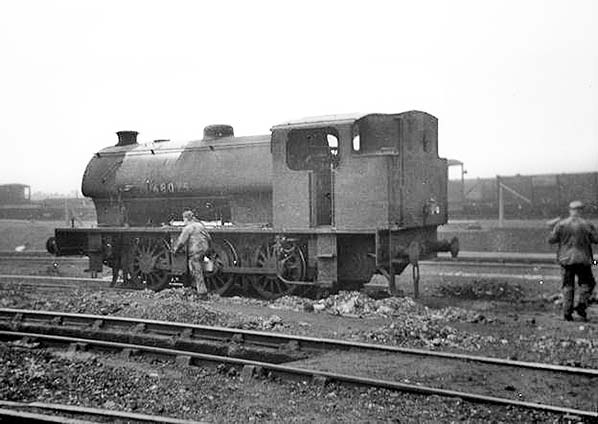
Class J94 0-6-0ST BR No.68075 at Hornsey sometime during 1959. The bunker modification and extra set of steps, the latter just ahead of the centre axle, can be seen. Despite being purchased by the LNER in 1946, on all but two examples the modifications were carried out by British Railways with No.68075 being dealt with in August 1948. She never saw wartime service, being new in March 1946 as WD 71536 and despite her 7xxxx number she never went abroad as she was sold to the LNER just three months later. It is possible that she was never used by the military, in which case she was, in effect, new to the LNER. Built by Andrew Barclay, w/n 2190/46, her career was short as she was withdrawn from 40E Colwick in December 1962 and did not outwit the scrap dealers. It is worth adding that the Austerity/J94 is often accredited to Robert Riddles, perhaps through his involvement with the WD 2-8-0 and 2-10-0 locomotives. Riddles was an LNWR, later LMS, man who moved to the Ministry of Supply (MoS) as their somewhat pompously, but not inaccurately, titled Director of Transportation Equipment in late 1939 - a post he held until 1943 when he returned to the LMS. While at the MoS Riddles would almost certainly have been the man who had his arm twisted by Hunslet and he would have had some input regarding the specification for the Hunslet 50550 class which was modified to become the Austerity saddle-tank. Thus whilst Riddles warranted some credit, he was by no stretch of the imagination the Austerity's designer.
Photo © John Firth and reproduced from Geograph under Creative Commons Licence
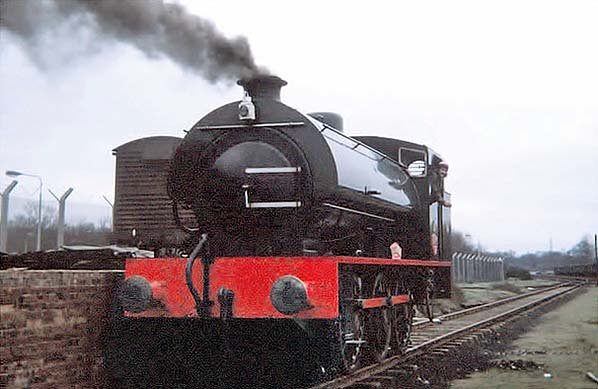
The dense smoke from the chimney of No.92 as she sits beside the coaling stage early one February morning in 1976 tell us she is being lit up. The term 'lit up', or 'lighting up' according to tense, is the time-honoured term for raising steam from cold. It refers literally to the lighting of the fire which usually involves a layer of wood and a shallow layer of coal, the whole being ignited by an oily rag, and further coal added once well alight. The process is gradual to permit even distribution of temperature and expansion of metals. A prerequisite, of course, is to first ensure there is adequate water in the boiler as injectors cannot operate until boiler pressure begins to rise. The time taken for a steam locomotive boiler to reach working pressure varies according to type and physical size; the Sentinel vertical boiler locomotives took as little as one hour but a large main line locomotive can take three to four hours. Working pressure of the Austerity Saddle Tank is 170psi., this taking around two hours to achieve from cold. This contrasts with an average main line diesel locomotive taking around fifteen minutes to be ready for service, including time taken for drivers to make routine pre-service checks. In the right background of this view is just visible the eastern end of the exchange sidings, with a number of vans present. The Fawley branch is behind the trees in the far background. The track seen diverging behind the locomotive is that serving the elevated coal siding. A van can be seen to the left of the locomotive and it is unclear if the van is on the coal siding or is merely a body propped-up on some sleepers or other type of blocks. Such a van would certainly not have been used for delivering coal.
Photo by Andy Crespin
Click here to continue Marchwood Military Railway



 WD 75189/Army152 'RENNES'. RSH 7139/1944. Served at Marchwood June 1953 to May 1956 as the replacement for WD 75290. Her next three years allocations are unknown but it is known that she lasted with the military only until 1959, after which she became another example rebuilt and resold by Hunslet to the NCB. She is now (2016) preserved at the Pontypool & Blaenavon Railway where she is be restored into LMR (Longmoor) livery, although this should not be taken as any proof that she was at Longmoor at any time during her military career. Nevertheless, Longmoor was often the last port of call for Army locomotives prior to disposal.
WD 75189/Army152 'RENNES'. RSH 7139/1944. Served at Marchwood June 1953 to May 1956 as the replacement for WD 75290. Her next three years allocations are unknown but it is known that she lasted with the military only until 1959, after which she became another example rebuilt and resold by Hunslet to the NCB. She is now (2016) preserved at the Pontypool & Blaenavon Railway where she is be restored into LMR (Longmoor) livery, although this should not be taken as any proof that she was at Longmoor at any time during her military career. Nevertheless, Longmoor was often the last port of call for Army locomotives prior to disposal. WD 71443/Army 157 'CONSTANTINE'. HE3207/1945. Little is known of this locomotive other than that she was at Marchwood from November 1955 until November 1958 and that she was withdrawn during 1962 and scrapped at Pollock & Brown, Southampton, sometime between then and March 1968. Curiously, however, there is a record of 'a' WD 157 ending up with Nederlandse Spoorwegen as their No.8802 but scrapped in October 1956. This must be assumed to be a different locomotive or possibly an error in the records.
WD 71443/Army 157 'CONSTANTINE'. HE3207/1945. Little is known of this locomotive other than that she was at Marchwood from November 1955 until November 1958 and that she was withdrawn during 1962 and scrapped at Pollock & Brown, Southampton, sometime between then and March 1968. Curiously, however, there is a record of 'a' WD 157 ending up with Nederlandse Spoorwegen as their No.8802 but scrapped in October 1956. This must be assumed to be a different locomotive or possibly an error in the records.

 Austerity WD 157 CONSTANTINE standing adjacent to the original locomotive shed, seen in the background, at Marchwood. The photograph was taken by a platelayer of the time who suggested the date "circa 1956" although given WD 157 was at Marchwood only for three years from November 1955 "circa" could arguably cover that entire period. Whatever the date, quite what was occurring is something of a mystery as the locomotive is dumped on a siding minus coupling rods and sandwiched between a platelayer's trolley and a van. She has MMR on her tank and white rimmed tyres which appear freshly painted (on railway wheels, especially locomotive wheels, a 'tyre' is a separate, flanged, component which is heated up and placed over the wheel which it then grips securely as it cools and contracts). The painting of rims in this manner was popular with the military, especially at Longmoor, and was also applied to some main line locomotives, usually diesels, especially when brand new, ex-works, for official photographs. It was not, however, very practical as the white soon became filthy. Often referred to as 'whitewall tyres', this term more correctly applies to road vehicles. WD 157 was photographed at Longmoor shortly before she moved to Marchwood but on that occasion did not have white rims. Similarly she did not appear to have white rims when photographed on the power station spur in January 1956 (photo below). The conclusion, therefore, is that this photograph dates from the time of her arrival at Marchwood, ie November 1955, and when she was being prepared for service. Readers may suspect the missing coupling rods were due to her being towed from Longmoor to Marchwood but locomotives being so-transferred usually did so under their own power. Close examination of her wheels shows the cranks to be in the same positions (roughly in the 11 o'clock position) and this tells us the coupling rods were removed after she arrived on the siding as seen here but the reason why is now lost in the mists of time. It is highly unlikely the rods were removed merely to facilitate painting the tyre rims as this can be done with rods in situ, although the absence of the rods probably encouraged a tin of white paint to appear. The goods van is marked 'LMR', ie Longmoor Military Railway. It is often forgotten that locomotives were not the only vehicles to be moved from depot to depot and it is possible this van, which is strongly suspected of being of Midland Railway origin, came to Marchwood with No.157. At far right another Austerity can be seen, it is likely to be either No.152 RENNES or No.106 SPYCK. Both display the usual bars over the cab rear lookouts, their purpose being to protect the glass from damage by coal. On the left part of another Nissen type building can be seen, purpose unknown. WD 157 was back at Longmoor by 1966 and in that year appeared in the film The Great St.Trinians Train Robbery. One of two Austerities used in the film, the other being WD 196, she was for some mysterious reason given dummy side tanks and in this form vaguely resembled an LNER/BR Class J50. She was also given BR livery and the number 68961; a real J50 which had been withdrawn in September 1962.
Austerity WD 157 CONSTANTINE standing adjacent to the original locomotive shed, seen in the background, at Marchwood. The photograph was taken by a platelayer of the time who suggested the date "circa 1956" although given WD 157 was at Marchwood only for three years from November 1955 "circa" could arguably cover that entire period. Whatever the date, quite what was occurring is something of a mystery as the locomotive is dumped on a siding minus coupling rods and sandwiched between a platelayer's trolley and a van. She has MMR on her tank and white rimmed tyres which appear freshly painted (on railway wheels, especially locomotive wheels, a 'tyre' is a separate, flanged, component which is heated up and placed over the wheel which it then grips securely as it cools and contracts). The painting of rims in this manner was popular with the military, especially at Longmoor, and was also applied to some main line locomotives, usually diesels, especially when brand new, ex-works, for official photographs. It was not, however, very practical as the white soon became filthy. Often referred to as 'whitewall tyres', this term more correctly applies to road vehicles. WD 157 was photographed at Longmoor shortly before she moved to Marchwood but on that occasion did not have white rims. Similarly she did not appear to have white rims when photographed on the power station spur in January 1956 (photo below). The conclusion, therefore, is that this photograph dates from the time of her arrival at Marchwood, ie November 1955, and when she was being prepared for service. Readers may suspect the missing coupling rods were due to her being towed from Longmoor to Marchwood but locomotives being so-transferred usually did so under their own power. Close examination of her wheels shows the cranks to be in the same positions (roughly in the 11 o'clock position) and this tells us the coupling rods were removed after she arrived on the siding as seen here but the reason why is now lost in the mists of time. It is highly unlikely the rods were removed merely to facilitate painting the tyre rims as this can be done with rods in situ, although the absence of the rods probably encouraged a tin of white paint to appear. The goods van is marked 'LMR', ie Longmoor Military Railway. It is often forgotten that locomotives were not the only vehicles to be moved from depot to depot and it is possible this van, which is strongly suspected of being of Midland Railway origin, came to Marchwood with No.157. At far right another Austerity can be seen, it is likely to be either No.152 RENNES or No.106 SPYCK. Both display the usual bars over the cab rear lookouts, their purpose being to protect the glass from damage by coal. On the left part of another Nissen type building can be seen, purpose unknown. WD 157 was back at Longmoor by 1966 and in that year appeared in the film The Great St.Trinians Train Robbery. One of two Austerities used in the film, the other being WD 196, she was for some mysterious reason given dummy side tanks and in this form vaguely resembled an LNER/BR Class J50. She was also given BR livery and the number 68961; a real J50 which had been withdrawn in September 1962.











 The regimental badge of the Royal Corps of Transport (RCT). The inscription "Honi soit qui mal y pense" is an Anglo - Norman maxim which loosely translates to "May he be shamed who thinks badly of it". The RCT's motto was "Nil sine labore" which translates to "Nothing without labour". As is typical within the military, the RCT had a number of nicknames of which some, based upon the initials 'RCT' were ever so slightly lampooning. However, one which was less lampooning was 'The Waggoners' and hence the WAGGONER name given to locomotive Army No.92. The Royal Corps of Transport was disbanded in 1993 and merged with other Corps to form the Royal Logistic Corps on and from 5 April that year.
The regimental badge of the Royal Corps of Transport (RCT). The inscription "Honi soit qui mal y pense" is an Anglo - Norman maxim which loosely translates to "May he be shamed who thinks badly of it". The RCT's motto was "Nil sine labore" which translates to "Nothing without labour". As is typical within the military, the RCT had a number of nicknames of which some, based upon the initials 'RCT' were ever so slightly lampooning. However, one which was less lampooning was 'The Waggoners' and hence the WAGGONER name given to locomotive Army No.92. The Royal Corps of Transport was disbanded in 1993 and merged with other Corps to form the Royal Logistic Corps on and from 5 April that year.


 Home Page
Home Page